This was published 2 years ago
Opinion
How the US broke Iraq: A generational mistake that killed 306,000 civilians
By Ishaan Tharoor
“You break it, you own it.” That’s the so-called Pottery Barn rule, famously invoked two decades ago by Secretary of State Colin Powell to President George W. Bush ahead of their administration’s decision to launch its invasion of Iraq.
In February 2003, Powell staked his considerable reputation on a presentation he delivered at the UN Security Council, offering to the world “facts and conclusions based on solid intelligence” about the Iraqi regime’s possession of so-called weapons of mass destruction.
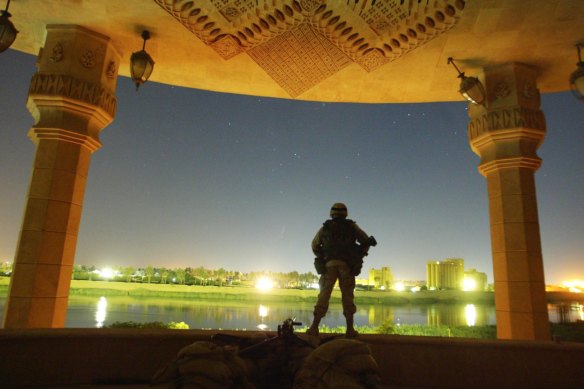
An American soldier in Baghdad in 2003.Credit: Jason South
In later years, he would lament the defects in the US intelligence process that led him to that moment, which preceded the Bush administration’s decision to launch its invasion.
Critics contend that figures in the Bush administration deliberately lied to get the war they wanted, but, whatever the case, Powell, who died in 2021, voiced more remorse than many of his immediate colleagues. And he was at least partially right about the Pottery Barn rule.
With little doubt, the United States broke Iraq. US forces succeeded in the campaign to topple Iraqi dictator Saddam Hussein, shocking and awing their way to Baghdad in a matter of days.
But what followed turned into a debacle for US grand strategy, and a traumatic nightmare for much of Iraqi society. An oppressive regime was ousted, but the initial glimmers of hope and optimism felt by some Iraqis faded as a dysfunctional, unstable status quo took root, shaped far too often by sectarian enmities and kleptocratic elites.
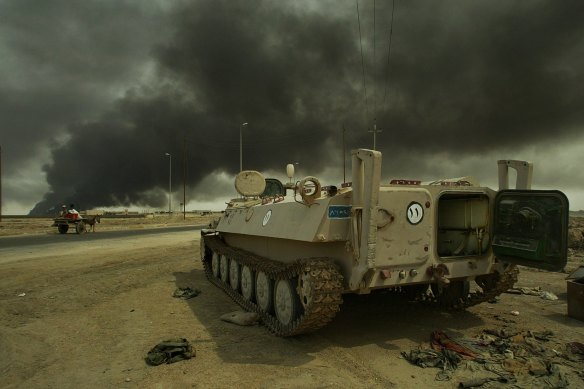
Smoke from oil fires fill the sky as a man and child ride their donkey-pulled cart past an abandoned Iraqi armoured personnel carrier on the road to Basra, during the first days of the invasion of Iraq in March, 2003.Credit: Kate Geraghty
The war, driven by the hubris of the Bush administration and a supportive Washington establishment – as well as what has to be described at this point as a vengeful post-9/11 bloodlust that permeated American society – is now widely seen as a generational American mistake.
Iraqis paid the biggest price: According to Brown University’s Costs of War project, many of the 306,000 estimated deaths in the Iraq war were of civilians killed by “direct war-related violence” between 2003 and 2019, a span of time that saw Iraq convulsed by waves of insurgencies and counterinsurgencies, and its cities ravaged by terrorist attacks and airstrikes.
The consensus now, even among formerly hawkish Republicans, is that the United States should never have invaded Iraq 20 years ago. But an older genre of conventional wisdom in Washington maintains that the Bush administration’s real failure came only after it deposed Saddam, when it turned out that the United States didn’t have a real strategy for managing what came next.
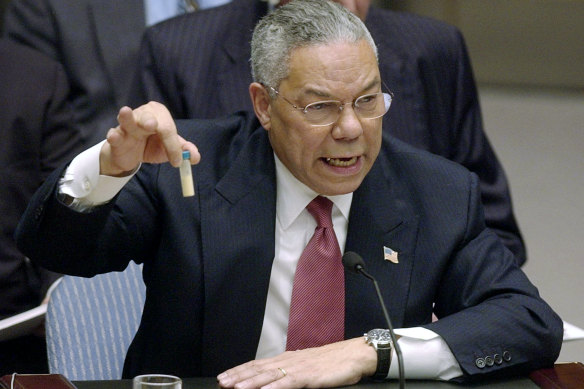
Colin Powell holds up a vial he said could contain anthrax as he presented evidence of Iraq’s alleged weapons programs to the UN Security Council in 2003.Credit: AP
“Had we gone to war with a real plan for what we would do once we liberated Baghdad,” wrote former Washington Post Baghdad bureau chief Rajiv Chandrasekaran last week, “had we sent language-proficient reconstruction experts instead of political sycophants, and had we sought to heed the wishes of millions of Iraqis to help them create a multi-sect, multiethnic, big-tent government, the history of the United States in Iraq over the past two decades would almost certainly look very different.”
That alternate reality is nice to consider when you have to gauge the actual reality. Many Iraqi critics of Saddam’s regime lament what was lost in his overthrow.
“Iraq quickly fell prey to chaos, conflict and instability, experienced an uncountable number of deaths and displacements, and the erosion of health, education and basic services,” wrote Iraqi academic Balsam Mustafa.
“Behind the statistics, there are untold stories of agony and suffering. The structural and political violence would spill into social and domestic violence, affecting women and children. With every life lost, a whole family is shattered. From day one, the conditions were forming for the emergence of terrorist groups and militias.”
Saddam’s nominally secular regime carried out hideous atrocities against ethnic Kurds and rebellious Shiites. But it still presided over a united sense of Iraqi identity that was, to a certain extent, broken up by the US invasion and its aftermath.
“One bloody dictator was killed and replaced with countless petty tyrants. Baghdad itself is no longer the city it was,” wrote Feurat Alani, a French-Iraqi journalist and author.
“With rare exceptions, Sunnis live in Sunni neighbourhoods, and Shiites in their own. In the rest of the country, the ‘soft partition’ of Iraq into a Kurdish north, a Sunni west and centre, and a Shiite south – an idea Joe Biden once championed – is a reality.”
In recent years, Iraqis of all backgrounds have tried to reclaim a sense of nationhood, despite the prevailing political order.
A youth-led protest movement has bitterly clashed with the Iraqi state and affiliated powerful militias; one of its cries is simply “we want a homeland.” Many in their ranks are from a new generation that barely knew of life under Saddam.
Noor Alhuda Saad, 26, a PhD candidate at Mustansiriya University who described herself to the Associated Press as a political activist, told the news agency that she and her compatriots are fighting for a more democratic and inclusive country that has so far failed to emerge two decades after the invasion.
“Young people like me are born into this environment and trying to change the situation,” she said. “The people in power do not see these as important issues for them to solve. And that is why we are active.”
The rot in the political order is in part because of the United States, which brought in a raft of US-backed exiles while also wholly dismantling the Saddam’s one-party Baathist state.
The long tail of those decisions can be seen in the Iraqi parliament’s constant struggles for legitimacy and the rise of the extremist Islamic State, which emerged with the organisational know-how of some former members of the Baath Party.
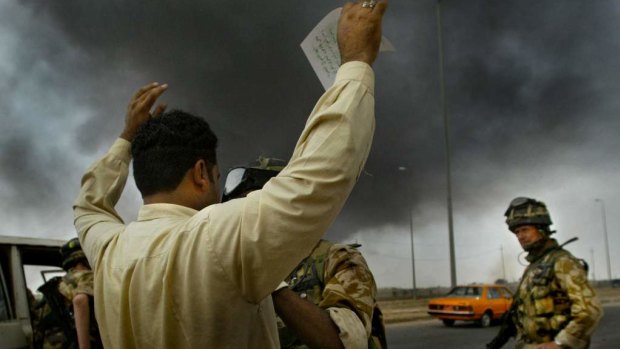
Searched by British soldiers, an Iraqi man on the outskirts of Basra holds his arms in the air clutching a leaflet written by the Coalition forces stating “People of Basra we are here to liberate the people of Iraq”.Credit: Kate Geraghty
But while the United States broke Iraq, it never quite owned it. A kind of curious amnesia has already set in about the conflict.
Because of the extremes of the Trump presidency, Bush has been rehabilitated in the national imagination as a sympathetic figure almost worthy of nostalgia.
Washington policy elites pin many of the failures in Iraq on the Iraqis who took power, with former prime minister Nuri al-Maliki singled out as a leading villain in the piece.
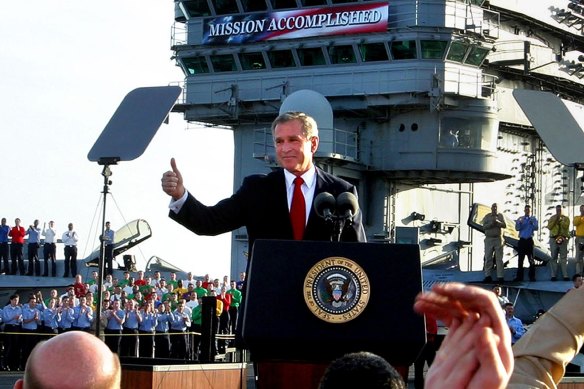
President Bush flashes a “thumbs-up” after declaring the end of major combat in Iraq in May 2003. The country would be convulsed by violence for years afterward.Credit: AP
Few Americans now pay attention to the active security role still played by hundreds of US “military contractors” operating in the country the United States invaded two decades ago, and technically fully withdrew from in 2021.
The United States suffered major loss in Iraq. More than 4000 US soldiers died there, while countless more returned home, wounded and traumatised.
Many veterans now question the purpose of the war and the sacrifices they were asked to make. According to a 2014 study, an estimated fifth of all US veterans who served in Iraq came back with PTSD.
And yet the wounds for ordinary Iraqis are far greater. My colleagues reported last week on the hidden toll of the toxic burn pits the United States left behind Iraq, as soldiers in US military bases incinerated their waste out in the open. The legacy of these pits is as visceral as it may seem metaphorical - leading to a long record of illness and disease for those exposed to them.
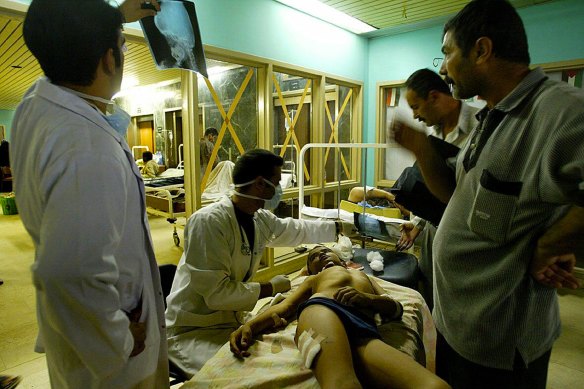
Akavi worked in Iraq in 2003, where she helped restock hospitals.Credit: Kate Geraghty
Recent US legislation signed by President Biden acknowledges the harm caused to some 200,000 U.S. service personnel suffering from burn-pit-related illnesses, and dramatically expanded benefits to them.
But it does nothing for the ordinary Iraqis who lived downwind of America’s smouldering debris.
“I think they consider those soldiers more human than us,” Zakaria Tamimi, whose family was ravaged by illness and death likely due to exposure to these toxic burn pits near a former base north of Baghdad, told my colleagues. “There’s no door for us to knock on.”
Washington Post
Get a note directly from our foreign correspondents on what’s making headlines around the world. Sign up for the weekly What in the World newsletter here.